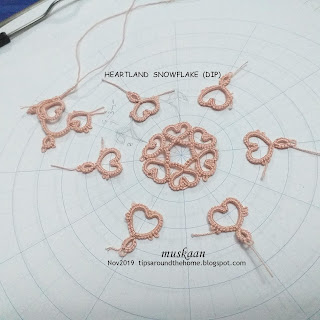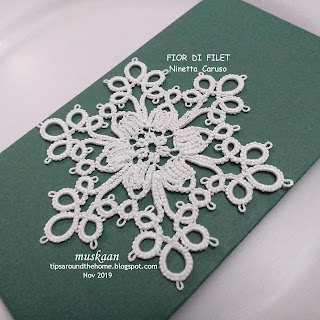Snowflake
#20 in Land of Laces’ 25
Snowflake Project
This
snowflake Can be worked in one pass. But I chose not to. I enjoyed creating it
in patchwork style, since it was easier to guesstimate during designing trials. And I had this idea of using rainbow colours in the outer hearts. With no
ends to sew in, it was fun!
I
made 2 joins between adjacent hearts in this round. When it started cupping, I
snipped off the outer picot and everything fell flat ;-P
After
the inner round, I made 1 heart & ring motif. On top left you can see
my chain trial around that motif. Seemed workable, and I went ahead with the 6 hearts. I used a
circular polar grid to keep everything in place, and also to figure out the
lengths.
On
the outer round, my idea was to have 2 rings joined in a pointed fashion to
create a kind of star round visually. In the first 2 repeats (clockwise from 7 o'clock position) itself it became
clear that the diameter was increasing. Hence tried without any rings. Then in
the last repeat I tried a single ring. With blocking, and stacking the double rings, the flake laid flat and I
chose single ring for that bit of snowflakiness!
The
center is not anything unusual. I’ve seen something similar. But just so I
wasn’t creating something from the recesses of my memory, I checked Sharon
Briggs’ blog for her designs last year. Phew, her’s are a bit different.
However, she did use the outer heart & ring combo in this heart pattern.
So, while not deliberate, I can surely see my inspiration derived from her
designs.
Both Anita Barry and her husband (thanks, P! 💖) felt the outer heart should have one stitch less. Tried it, and Loved the shape. So, the red one in size 40, has that tweaked count. My feat of messing up he chain arches was unfounded, I think? And I added picots in the center - a bit denser now, although the rainbow one is again without picots, since I cannot decide.
Both Anita Barry and her husband (thanks, P! 💖) felt the outer heart should have one stitch less. Tried it, and Loved the shape. So, the red one in size 40, has that tweaked count. My feat of messing up he chain arches was unfounded, I think? And I added picots in the center - a bit denser now, although the rainbow one is again without picots, since I cannot decide.
I’ll
share the pattern for Heartland Snowflake tomorrow when I finish my rainbow model. Hope you like this
20th flake; 5 more to go. Technically I count 20, but if I include
all the versions/variations, the count is already at about 40! Not bad for a
tentative start in June!
















































